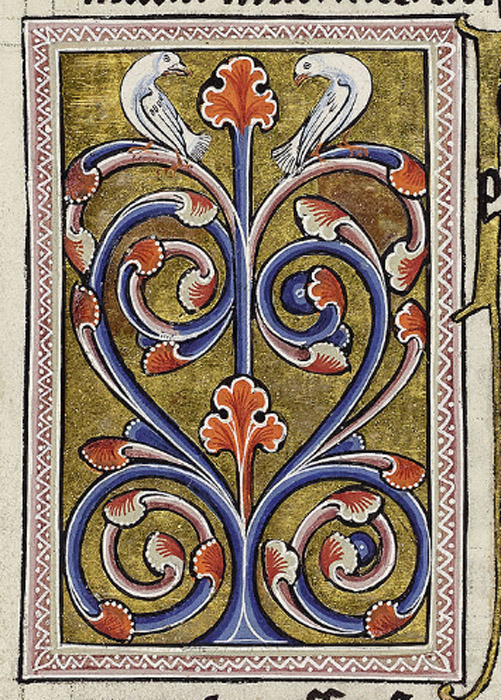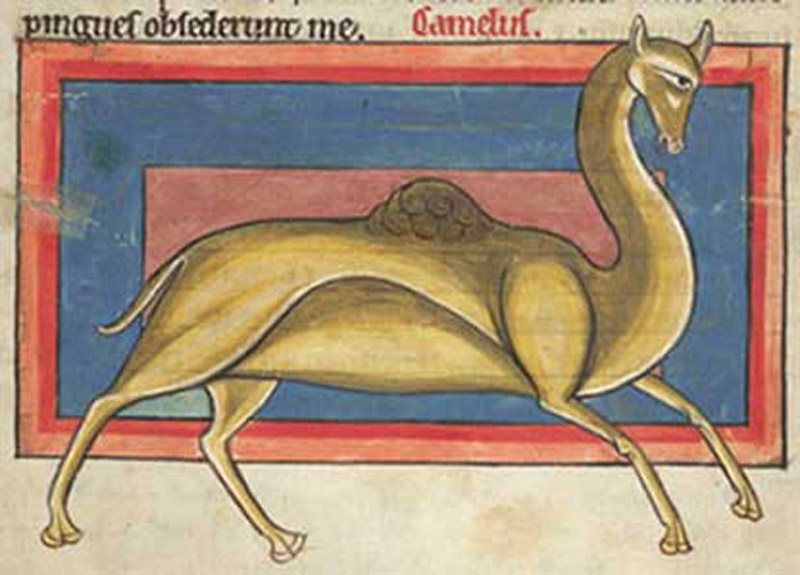
A woman holding a dove stands in a vesica with six doves in its border. She wears a red tunic, a blue mantel and has a brown hood. The whole scene is surrounded by an exquisite frame. There is extensive commentary on this image.
Text Translation:
Of the cedar and the sparrows that nest in its branches When the words ‘cedar’ and ‘Lebanon’ are placed together, it is in a good sense. As Solomon says in the Song of Songs: ‘his countenance is as Lebanon, excellent as the cedars’ (5:15). Lebanon is a mountain of Phoenicia at the northern limit of Judaea. Its trees surpass the timber of other trees in height, appearance and strength. By Mount Lebanon we can doubtless understand excellence in virtues. It stands at the northern limit of Judaea, to prevent the Devil from entering by means of temptation the minds of those who are sincerely praising the Lord. Its trees surpass others in height, appearance and strength, as every faithful soul surpasses others in the exalted nature of its desire, the splendour of its chastity and the strength of its constancy. By the cedar we understand Christ. He is the tall cedar of Lebanon, similar in form to the hyssop which, although it grew tall, was made humble.
Sparrows are preachers. Their fledglings are those born of the word as it is preached. Their nest is a place where there is peace of mind. Build your nest in the cedar, therefore, if you are one of those who, by living at peace, have not given up hope of eternal bliss. There are those cedars of Lebanon which the Lord planted. They represent the rich of the world. Sparrows represent the heads of monasteries; fledglings are their disciples. The nest represents convent buildings. Sparrows nest in these cedars, because spiritual rulers place their convents on the estates of the rich. There the sparrows call ceaselessly, seeking food from God. Let all those who wish to be filled with the word of God as with food, seek their nourishment from him. Day and night the sparrows call out, like those who pray with all their heart to God on behalf of their benefactors. Their minds at peace in the midst of the world, they care for their wings, the wings of contemplation, on which they seek to fly to the cedar as swiftly as they can. They fly around the trees of Lebanon, because they wish to know of the life and behaviour of spiritually eminent men. From this timber of Lebanon we read that Solomon made himself a chariot (see Song of Songs, 3:9), as the Church was made from illustrious and untiring men. Again of the cedar There are those cedars which the Lord did not plant. He did not plant them of his own will, he did not extend their number out of desire. ‘Every plant which my heavenly Father hath not planted shall be rooted up’ (Matthew, 15:13)
These cedars of Lebanon are the rich and proud. Gyrfalcons and hawks nest in them that is, birds of prey. They make nests there as robbers build strongholds on the estates of the rich. Their fledglings are their accomplices or henchmen. These birds hide in the the cedars in order to catch their prey, as robbers are empowered to commit crimes by evil rulers. But ‘the Lord breaketh the cedars of Lebanon’ (Psalms, 29:5), that is, he will destroy the rich of the world, some by repentance, some by vengeance. The Lord will break some by repentance as he will humble the calf of Lebanon. He will humble them like the calf of Lebanon (see BSV, Psalmi, 28:6; NEB, Psalms, 29:6), in imitation of the life of Christ, making of each rich man a calf fit for sacrifice, who will mortify his flesh and carry his cross with Christ. He will break others by vengeance because they will be kept for eternal fire. Many profit from the felling of the aforesaid cedar, as when Christ with his death redeemed the world. ‘Except a corn of wheat fall into the ground and die, it abideth alone; but if it die, it bringeth forth much fruit’ (John, 12:24). Therefore the felling of the cedar represents the death of Christ. Truly, many benefitted from the death of Christ; by descending into hell, rising from the dead and ascending into heaven, he gave to the dying the hope of resurrection. For what good is there in living afflicted by distress and in dying at the end, if hope of resurrection does not follow? And what good is resurrection unless it is agreed that immortal man lives on without endless punishment? Likewise, when the cedar which the Lord planted is felled, it is of great profit, because it is transferred to the dwelling-place of eternal bliss. But if the cedar which the Lord did not plant is felled, it, too, will be of no little use, because the tree which bore no fruit in Lebanon, that is, in this secular world, may, when it is felled, support the weight of the building in a temple of the spirit. What I have said applies only if you cut down the pride of the cedar with repentance. If, however, you cut it down with vengeance, you consign it to the fires of Gehenna to be reduced forever to ashes.


































